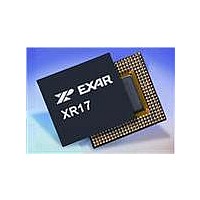XR17V258IV-F Exar Corporation, XR17V258IV-F Datasheet - Page 50

XR17V258IV-F
Manufacturer Part Number
XR17V258IV-F
Description
IC UART PCI BUS OCTAL 144LQFP
Manufacturer
Exar Corporation
Type
Octal UARTr
Datasheet
1.XR17V258IVTR-F.pdf
(69 pages)
Specifications of XR17V258IV-F
Number Of Channels
8
Package / Case
144-LQFP
Features
*
Fifo's
64 Byte
Protocol
RS485
Voltage - Supply
3.3V, 5V
With Auto Flow Control
Yes
With Irda Encoder/decoder
Yes
With False Start Bit Detection
Yes
With Modem Control
Yes
Mounting Type
Surface Mount
Data Rate
8 Mbps
Supply Voltage (max)
3.6 V
Supply Voltage (min)
3 V
Supply Current
4 mA
Maximum Operating Temperature
+ 85 C
Minimum Operating Temperature
- 45 C
Mounting Style
SMD/SMT
Operating Supply Voltage
3 V to 3.6 V
No. Of Channels
8
Uart Features
Tx/Rx FIFO Counters
Supply Voltage Range
3V To 3.6V
Operating Temperature Range
-40°C To +85°C
Digital Ic Case Style
LQFP
No. Of Pins
144
Rohs Compliant
Yes
Lead Free Status / RoHS Status
Lead free / RoHS Compliant
Lead Free Status / RoHS Status
Lead free / RoHS Compliant, Lead free / RoHS Compliant
Available stocks
Company
Part Number
Manufacturer
Quantity
Price
Company:
Part Number:
XR17V258IV-F
Manufacturer:
EXAR
Quantity:
295
Company:
Part Number:
XR17V258IV-F
Manufacturer:
Exar Corporation
Quantity:
10 000
Part Number:
XR17V258IV-F
Manufacturer:
EXAR/艾科嘉
Quantity:
20 000
XR17V258
66MHZ PCI BUS OCTAL UART WITH POWER MANAGEMENT SUPPORT
The MCR register is used for controlling the modem interface signals or general purpose inputs/outputs.
MCR[7]: Clock Prescaler Select (requires EFR bit [4]=1)
•
•
MCR[6]: Infrared Encoder/Decoder Enable (requires EFR bit [4]=1)
The state of this bit depends on the sampled logic level of pin ENIR during power up, following a hardware
reset (rising edge of RST# input). Afterward user can override this bit for desired operation.
•
•
MCR[5]: Xon-Any Enable (requires EFR bit [4]=1)
•
•
MCR[4]: Internal Loopback Enable
•
•
MCR[3]: Send Char Immediate (OP2 in Local Loopback Mode)
This bit is used to transmit a character immediately irrespective of the bytes currently in the transmit FIFO. The
data byte must be loaded into the transmit holding register (THR) immediately following the write to this bit (to
set it to a ’1’). In other words, no other register must be accessed between setting this bit and writing to the
THR. The loaded byte will be transmitted ahead of all the bytes in the TX FIFO, immediately after the character
currently being shifted out of the transmit shift register is sent out. The existing line parameters (parity, stop
bits) will be used when composing the character. This bit is self clearing, therefore, must be set before sending
a custom character each time. Please note that the Transmitter must be enabled for this function (MSR[3] = 0).
Also, if software flow control is enabled, the software flow control characters (Xon, Xoff) have higher priority
and will get shifted out before the custom byte is transmitted.
•
•
In Local Loopback Mode (MCR[4] = 1), this bit acts as the legacy OP2 output and controls the CD bit in the
MSR register as shown in
Mode.
MCR[2]: DTR# or RTS# for Auto Flow Control (OP1 in Local Loopback Mode)
DTR# or RTS# auto hardware flow control select. This bit is in effect only when auto RTS/DTR is enabled by
EFR bit [6]. DTR# selection is associated with DSR# and RTS# is with CTS#.
•
•
In Local Loopback mode (MCR[4] = 1), this bit acts as the legacy OP1 output and controls the RI bit in the MSR
register, as shown in
5.8
Logic 0 = Divide by one. The input clock from the crystal or external clock is fed directly to the Programmable
Baud Rate Generator without further modification, i.e., divide by one (default).
Logic 1 = Divide by four. The prescaler divides the input clock from the crystal or external clock by four and
feeds it to the Programmable Baud Rate Generator, hence, data rates become one forth.
Logic 0 = Enable the standard modem receive and transmit character interface.
Logic 1 = Enable infrared IrDA receive and transmit inputs/outputs. While in this mode, the TX/RX output/
input are routed to the infrared encoder/decoder. The data input and output levels will conform to the IrDA
infrared interface requirement. As such, while in this mode the infrared TX output will be a LOW during idle
data conditions. FCTR bit [4] may be selected to invert the RX input signal level going to the decoder for
infrared modules that provide rather an inverted output.
Logic 0 = Disable Xon-Any function (default).
Logic 1 = Enable Xon-Any function. In this mode any RX character received will enable Xon, resume data
transmission.
Logic 1 = Disable loopback mode (default).
Logic 1 = Enable local loopback mode, see loopback section and
Logic 0 = Send Char Immediate disabled (default).
Logic 1 = Send Char Immediate enabled.
Logic 0 = Uses RTS# and CTS# pins for auto hardware flow control.
Logic 1 = Uses DTR# and DSR# pins for auto hardware flow control.
Modem Control Register (MCR) - Read/Write
Figure 14
Figure 14
.
. Please make sure that this bit is a ’0’ when exiting the Local Loopback
50
Figure 14
.
REV. 1.0.2












